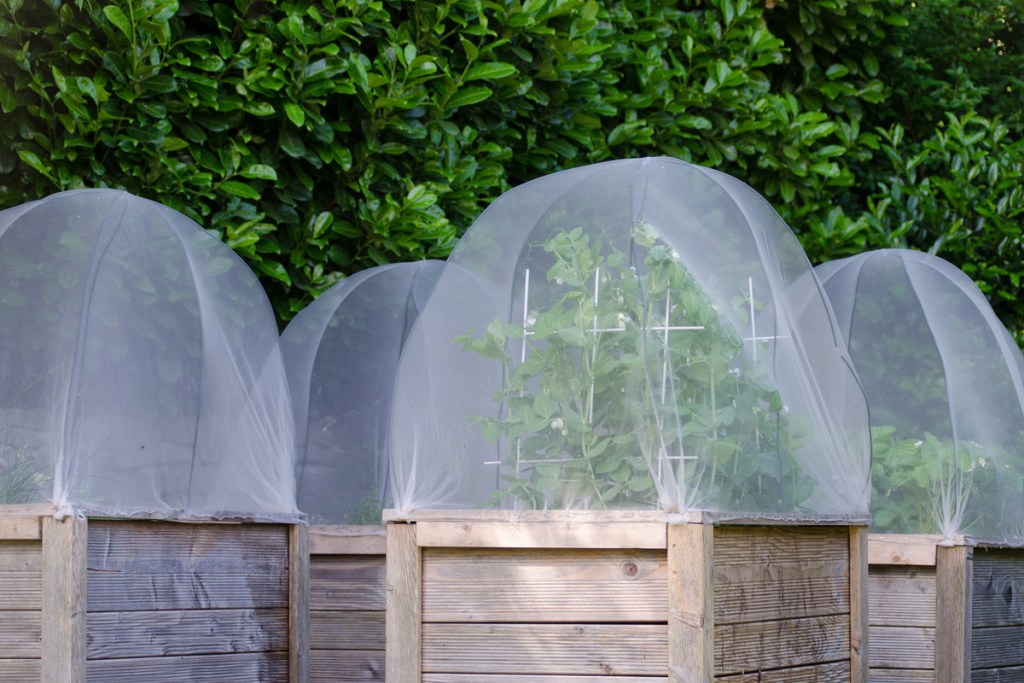Insects are a normal part of gardening and are very important for the ecosystem, but that doesn’t mean you want them eating your plants. Experienced gardeners often have methods they swear by and have been gardening long enough to know which methods work for them and which ones don’t. If you’re just starting out, though, you’ll need a good starting place. Pest control can take a little trial and error, since different methods work better in different environments or with different pests. Here are some great, easy pest control methods that make a great place to start.
Build a barrier
The easiest way to deal with pests is to keep them from getting to your plants in the first place. There are a few different ways you can use barriers to keep them out. The easiest pests to keep out are ground-crawling insects.
Having a raised garden bordered by a low wall is one way to keep them out. However, if you’ve already planted your garden and can’t transition the plants into a raised bed, you can still receive some benefits from a low wall around your garden.
If you’d rather not surround your entire garden, you can instead surround individual plants. Plant collars are barriers that wrap around individual plants. You can make plant collars easily at home out of whatever material you have on hand as long as it is relatively rigid and weather resistant. The collar needs to be half the height of the plant and go several inches into the ground as well to prevent tunneling pests and for stability.
Flying insects are harder to keep out, but there are also fewer flying insects that need to be kept out. While some flying insects are pests, many of them are necessary pollinators. Once your plants have been pollinated, you can lay insect netting over them. Be sure the netting you choose lets light in, though, or you may have bigger problems to worry about.
Manage the environment
There are also a few things you can do to make your garden unappealing for pests. Many pests hide in excess greenery or foliage. Regular weeding and a strip of bare earth between your garden and other plants reduces the amount of habitat available for insects, leaving them exposed.
You can also plant plants that insects hate, discouraging them from venturing into your garden. Many insects dislike the strong scents of herbs that we tend to enjoy. Rosemary in particular repels insects that tend to prey on vegetables. Planting a border of rosemary can reduce the number of insects in your garden. However, there hasn’t been very much research into how many plants are needed to be effective or how close together they need to be. So this method may need some trial and error and is likely best when used with other methods.
Making your garden more attractive for the animals and insects that prey on the insects that are bothering you is another option. This method varies depending on which insects you’re having difficulty with, of course, but some general suggestions are to put up bird feeders or add a water feature, such as a pond.
Try these remedies
Once pests are in your garden, however, your best bet is to use a spray. There are a range of products available online and at local retailers, but there are also sprays you can make at home. Some pesticides work better on certain insects or types of insects, so be sure to read labels carefully. One commonly used garden spray is permethrin spray, which is also available as a powder. It’s derived from a chemical found in chrysanthemums, making it a more natural solution than some other pesticides.
For many types of insects, a simple saltwater spray will kill them. However, it needs to be applied directly to the insect, making it less effective for prevention. Saltwater is more effective against soft-bodied insects, such as slugs and snails, but can still kill hard-bodied insects like ants and beetles.
You can also make a soap spray by mixing one cup of any oil with one tablespoon of soap and adding two tablespoons of the mixture to one cup of warm water. Fill a spray bottle with the mixture and spray away. This mixture is best against soft-bodied insects, especially small ones like aphids and mites. Be sure to use a soap that doesn’t contain bleach or any degreasing agent, as these can break down the oil you mix it with.
Now you can start the process of figuring out which methods work best for you! These are great starting places, but it’s important to remember that there are a lot of factors that impact the effectiveness of a pest control method. Things like climate, location, and insect type are just a few of the potential factors. Most people see better results when combining multiple methods, but feel free to try as many as you’d like. Whether you combine plant collars and soap sprays or raised beds and attracting predators, good luck and good gardening!
Editors' Recommendations
- Plant these stunning flowering shrubs for a showstopping garden display this spring
- 3 incredible reasons why you should be using coffee grounds in your garden
- Have a gross mealybug infestation on your plants? Try one of these remedies
- These plants should be among the first you plant this year
- Unique and whimsical flowers to add to your collection for a fairy-tale garden landscape this spring








